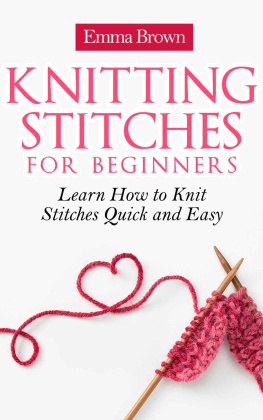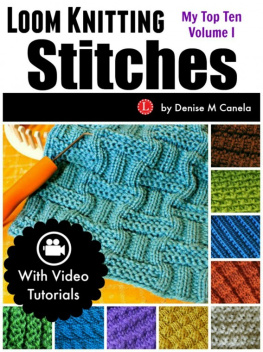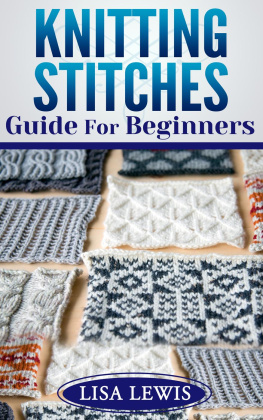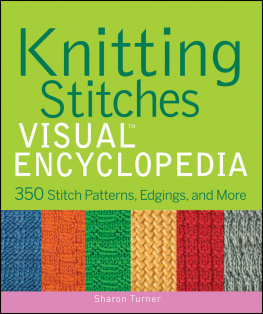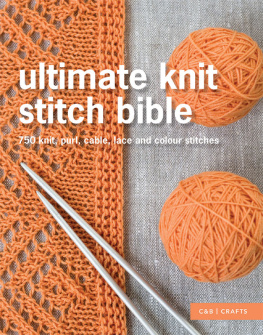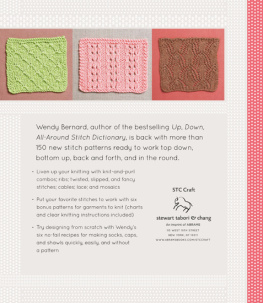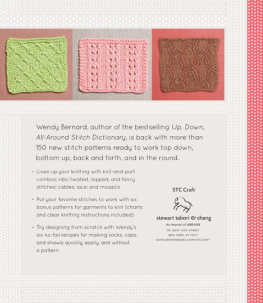Knitting Stitch Patterns Handbook
Knitting Made Easy, Volume 1
Donna Moore
Published by Donna Moore, 2014.
While every precaution has been taken in the preparation of this book, the publisher assumes no responsibility for errors or omissions, or for damages resulting from the use of the information contained herein.
KNITTING STITCH PATTERNS HANDBOOK
First edition. April 23, 2014.
Copyright 2014 Donna Moore.
ISBN: 978-1498990868
Written by Donna Moore.
10 9 8 7 6 5 4 3 2 1
Also by Donna Moore
Knitting Made Easy
Knitting Stitch Patterns Handbook
Beginners Handbook Of Scarf Knitting
2 Book Bundle: "Knitting Stitch Patterns Handbook" & "Beginners Handbook Of Scarf Knitting"
2 Book Bundle: "Knitting Stitch Patterns Handbook" & "Sock Knitting For Beginners"
2 Book Bundle: "Sock Knitting For Beginners" & "Beginners Handbook of Scarf Knitting"
3 Book Bundle: "Knitting Stitch Patterns Handbook" & "Beginners Handbook Of Scarf Knitting" & "Sock Knitting For Beginners"
Introduction
O nce youve mastered knitting and purling, you can tackle nearly any knitting pattern, if youve got the concentration and focus. Even the most complex knitting patterns are made up of knit stitches, purl stitches, increases and decreases. These same stitches produce cables, lace, and brioche stitch. They are used for mosaic, stranded, intarsia and double knitting.
This book is a stitch dictionary, providing you with the ability to look up a wide variety of knitting patterns. The first chapters provide you with an introduction or review of knitting and purling, followed by a detailed look at different types of increases and decreases. Next, youll find a chapter devoted to knitting gauge with a simple formula for an afghan square, dishcloth or simple scarf. This formula will allow you to use any of the stitch patterns to create a practice piece that you can use and enjoy.
Knitting patterns can be in written form or charted, so well review how to read a knitting pattern, including common abbreviations and chart symbols. While theyre not always standardized, a style sheet will help you decipher most knitting patterns, and will show you how to read the charts in this book. Here, well also introduce some helpful tools for pattern knitting to help you keep track of your place, reduce errors and stitch your way to success. Youll find the patterns in this book in both written, and where helpful, charted form.
The first pattern chapters review simple pattern stitches, including various types of ribbing, seed and moss stitch. Later chapters introduce cables, lace and other knitting techniques, building upon what you already know. Knit swatches or project examples illustrate stitches of various sorts, along with pattern charts, and where necessary diagrams. When special tools or techniques are required, well share those too for each type of stitch pattern.
These stitch patterns dont tell you how to knit a sweater or a pair of socks; however, experienced knitters can work out their gauge and integrate a stitch pattern into another pattern. For example adding a lace panel to the front of a sweater or working cables into their sock pattern. Beginners or intermediate knitters will find these stitch patterns an ideal way to practice skills, whether you opt for a simple square washcloth or knit an entire scarf. You can even combine patterns and knit a sample scarf or afghan to master a wide variety of stitch patterns in a single project.
Chapter 1: Knitting and Purling
I f youre using this book, you likely already know how to knit and purl. However, if youre returning to knitting after a long absence, a review wont hurt. Weve also included a quick guide to some common errors that may not be noticeable on simple knitting, but can rapidly become apparent as you move into more complex knitting patterns. Since this is a stitch dictionary, rather than a how-to-knit book, were not covering casting on or binding off in this book. Youll also want to check your favorite beginner knitting book or website for an overview of English and Continental knitting styles, as well as hybrids of the two. You can knit any pattern using the method you preferas long as it produces even stitches that face the right way, youre good to go.
The knit stitch and the purl stitch are the basic building blocks of all knitting patterns. Worked flat with each row knit, the knit stitch produces garter stitch. Worked in the round or in tandem with purl rows, the knit stitch produces stockinette stitch. Knit and purl stitches combine on the right side of the work to form ribbing, seed and moss stitch patterns. These stitches are also an essential part of nearly every other knitting pattern. Theyre also the basis of increase and decrease stitches of all sorts.
Knit stitches always begin with the yarn behind the work and your work facing you. To make a knit stitch, insert the tip of the right hand needle into the front loop of the first stitch on the left hand needle. The needle is inserted from below the stitch, moving upward and toward the back. It should, when properly placed, be sitting directly behind the left hand needle before you progress with the stitch. Pull up a loop, either by picking, in the Continental style, or throwing, in the English style. You now have both the original stitch on the left hand needle and the newly created stitch on the right hand needle. Drop the original stitch off of the left hand needle. Youve now completed one knit stitch. Knit stitches look like vs when viewed from the front side of the work.

T he purl stitch is essentially the reverse of the knit stitch. When purling, the yarn should be to the front of the work, facing you. To purl, you will insert the right hand needle into the front loop of the first stitch on the left hand needle. Rather than inserting the needle up and back, it will go down and forward. Pick or wrap the yarn around the needle in a downward, counter-clockwise direction and pull the new purl stitch through the loop. Drop the old stitch off of the left and needle. Purl stitches look like horizontal bumps when viewed from the front of the work. The backside of a knit stitch is a purl stitch and the backside of a purl stitch is a knit stitch.

O ccasionally, and even in this book, youll see a pattern ask you to knit or purl through the back loop. While both knit and purl stitches are normally worked through the front loop of the stitch, occasionally the stitch is twisted. Twisted stitches are typically created by knitting through the back loop, rather than the front loop, of the stitch. The twisted stitch has a slightly different appearance than one knitted through the front loop.
Common Problems
T here are a few relatively common problems with the basic knit and purl stitch. First, some people will begin knitting through the back loop, twisting every stitch. While this happens occasionally, it is much more common for new knitters or even intermediate knitters to twist purl stitches. A twisted stitch will present on the needle the wrong way, with the back loop closer to the end of the needle than the front loop. Purl stitches are not typically twisted by purling through the back loop, but by wrapping the yarn in the wrong, or a clockwise direction. If you find twisted stitches in your work, you can correct the alignment of the stitch on the needle by knitting through the back loop of the twisted stitch.


